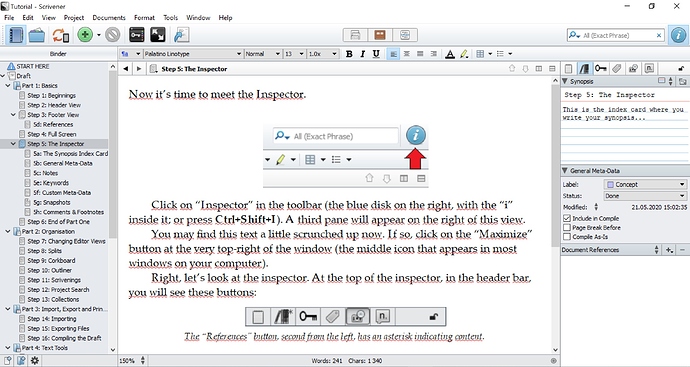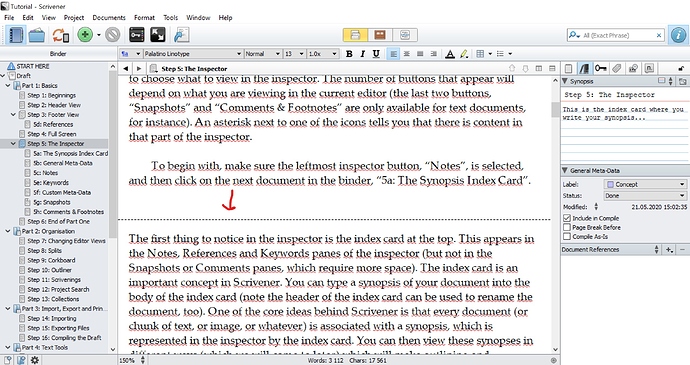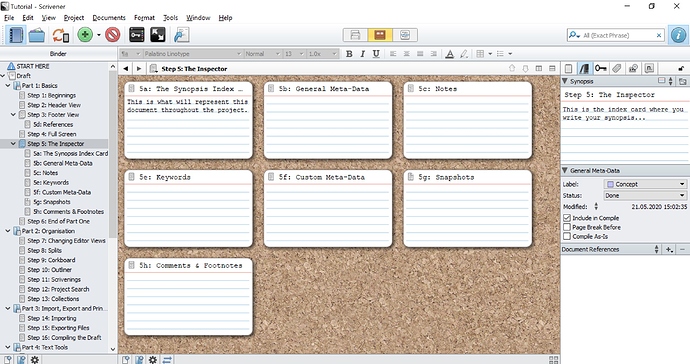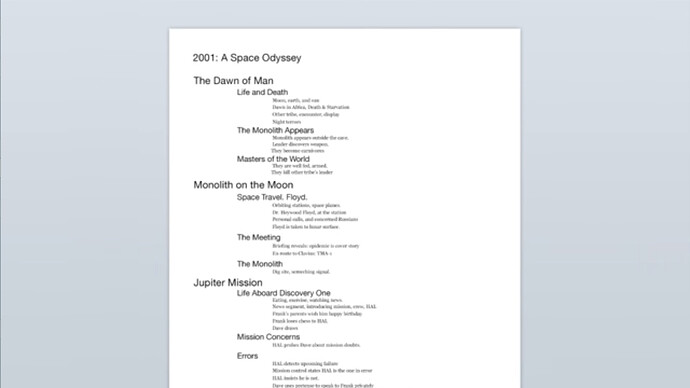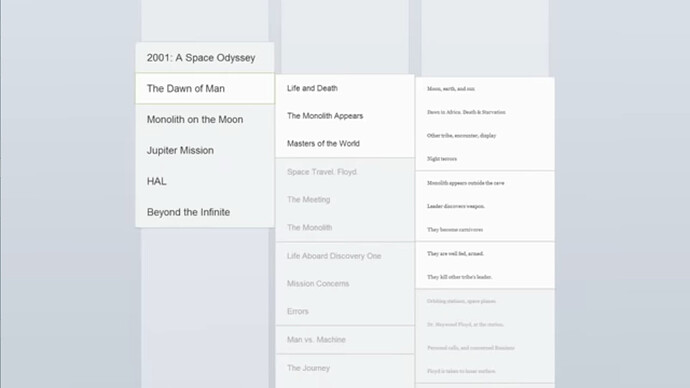A plugin that would emulate what apps like Ulysses or Scrivener can do, by chaining together multiple documents. This might be done by naming the documents sequentially depending on the order they appear in the file browser. If multiple documents are selected they would appear as one document in the editor - with section/page break lines where the documents split. Reordering documents in the browser would automatically rename them. It would also work with documents in folders, so one could essentially have a nested outline in the file browser, without having to have outline features in the editor itself. (Better for long form writing.) There should also be an option to then output the entire document (folder) as a single DOC or PDF file with nice formatting.
maybe I am missing something, can’t you just create a note that embeds your chapters?
![[Book - Part1]]
![[Book - Part2]]
…
This solution might make sense for making a final export document, but it does not work well for the creative writing process.
- Right now I don’t believe you can edit embedded documents? So if you switch to a document to edit you lose the context. Context is important for writing, which is why the apps I described let you see that when you need it.
- Even if you could edit embeds, you can not easily break up documents into sub sections, or move them around using the file manager, the way you can in the apps I mentioned. One of the main advantages of this system is making use of the file managers natural outlining ability (folders and sub folders), to make up for the fact the the Obsidian editor is not (and probably never will be) a true outliner. For instance, it gives you zooming ability, allowing you to look at a section, a paragraph, or a whole document depending on what is selected. The embed solution lacks this zooming function.
Once you have a document that embeds the chapters, can’t you just zoom by opening the chapter in a new tab?
Anyway, i do understand what you have in mind. Probably this workflow just doesn’t match the way I personally work.
It’s definitely a valid proposal for plugin!
One alternative is to cmd/ctrl-click on an embed link in a preview page. This opens the embedded page in a separate pane so you maintain your context. Though for this to worrk properly a bug needs to be fixed: when you update an embedded file, the embedding preview is not updated.
thanks @scmwiz, I saw the bug report you did!
Absolutely support you. I guess you’re talking about the corkboard functionality of scrivener where you can see small snippets of text and rearrange them really quickly and conveniently. Indeed, if that was in Obsidian, it would convert a lot of writers, I’m sure.
For those unfamiliar I created several screenshots to demonstrate this extremely useful functionality. Hopefully one day it’s in Obsidian.
-
On the left pane you can see that I have “Step 5” selected which is “above” several other documents. Both the Step 5 document and the subdocuments (5a, 5b etc.) have some content in them. So this view is simple, only the contents of “Step 5” are shown:
-
Next, there’s this Scrivener view where (see yellow-highlighted button in the middle and top of the screen). With no single keystroke and just a click of a button I’ve combined “Step 5” with all the documents (5a, 5b…) that are nested below it. Super helpful when working on an article or a book chapter and zero typing required:
-
This “corkboard view” allows to rearrange subdocuments (5a, 5b…) of “Step 5” as cards my dragging them around. On the cards you can see some meta-data (in this case could be abstract, synopsis etc.) and not the content of the subdocuments:
-
This is a listed view of all the subdocuments (5a, 5b…) of “Step 5” showing more metadata. Also useful in a way and imagine what Obsidian could do with this - tag lists, link lists, backlink lists, number of connections etc:
I was actually thinking about Ulysses, but the two apps have some similarities. Here is how to split, merge, and glue sheets in Ulysses, but it also works in terms of Export and document organization, etc.
This is such a good idea. This is something I am definitely missing from Roam as well, in the sidebar. When you shift-click load multiple documents into the sidebar, you end up with a single pane full of multiple documents that you can reference and edit seamlessly. And remove documents from the queue when you are done with them.
This is very different than splitting panes. When you are splitting past 3 or 4 documents, you can end up with a huge amount of headers, and you can’t scroll them all together in one contiguous view, like Scrivenings.
This contiguous, seamless view is amazing for synthesizing ideas from multiple documents into one. It is also great for loading up a queue of unrelated documents you want to edit, without a huge cluttered multi-header split.
This will be a really great feature to have. I like the file embeds, but they show up as iframes windows and you have to scroll each one — it will be much better to have them organically connected. Perhaps something like:
![[Book - Part1]]
![[Book - Part2]]
Option: MERGE EMBEDS INTO A NEW FILE
Hi @romanov.maxim as far as I understand, I think this thread is more about having a temporary editable view of a selection or collection of multiple notes. Not a destructive or additive merge operation.
In Scrivener’s Scrivenenings view, or in Ulysses, if you select multiple notes, you see them chained together in a contiguous view, and can edit them, or just read and compare them. When you deselect them, that view is gone, without having modified each individual note.
Scrivener was illustrated above. Here is how it works in Ulysses:
I will be happy with either option. Non-destructive, preferably.
Another inspiring layout/implementation, which fulfills this request/plugin-idea plus allows to keep synopsis/overview at multiple levels, is Gingko. See 80 seconds video in:
Related functionality within Obsidian is vertically oriented Andy mode. Looking forward to see it as native option within Sliding panes (Andy mode) plugin.
keywords: continuous, sequence, view
Have there been any developments on this front? Having the ability to “chain” together documents, combined with the recent Citations plugin, will enable me to shift my entire writing process from Scrivener to Obsidian. Thanks!
Definitely @malecjan! The idea of a more useful and clearer outliner seems to be realised in the https://gingkowriter.com/ . The recipy?
Taking the outline and separate the different levels horizontally. It allows you to work on granular level, but keeps you in the big picture at the same time, to navigate and restructure the document. Very ADHD-friendly! @tallguyjenks puts it here nicely: https://youtu.be/dxCJHHWyNzY
What do you think @WhiteNoise ?
examples in Ginko:
Related to plugin/FR ideas in these posts:
https://forum.obsidian.md/t/outline-core-plugin-improvement/9540?u=sofortlos
+1 to this as well. This ability of Ulysses / Scrivener is really key to many writers.
+1 behause it fills an important gap in knowledge management with obsidian:
knowledge transfer into hierarchical structure 
- Gingko Desktop would certainly be a good basis to enable a local API
- Or a plugin based on the Gingko Source Code created by this amazing community
(like a hybrid of Mindmap and Kanban)
- maybe thats a way?
Until this becomes a feature or plugin, try Settings > Editor > Fold heading (& optionally Fold indent). With this and the Fold all and Unfold all commands you can:
- Fold all headings to get an overview.
- Use a comment or even nothing as heading text if you don’t need a real heading — it will still fold. (These also appear in the Outline core plugin’s view.)
- Unfold the 1 section you want to work on.
- Unfold all to see the whole document
- Select and drag or cut-paste folded sections to change the order.
I’ve long been intrigued by Scrivener’s corkboard and I’ve used Ulysses’s pasting a little, but this works well enough for me (maybe better, for my taste). I often fold all and then unfold 1 to navigate a document. Some will still prefer full document spanning, of course.
